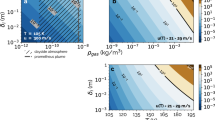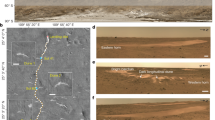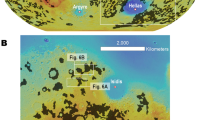Abstract
The martian surface is a natural laboratory for testing our understanding of the physics of aeolian (wind-related) processes in an environment different from that of Earth. Martian surface markings and atmospheric opacity are time-variable, indicating that fine particles at the surface are mobilized regularly by wind1,2,3. Regolith (unconsolidated surface material) at the Mars Exploration Rover Opportunity's landing site has been affected greatly by wind, which has created and reoriented bedforms, sorted grains, and eroded bedrock. Aeolian features here preserve a unique record of changing wind direction and wind strength. Here we present an in situ examination of a martian bright wind streak, which provides evidence consistent with a previously proposed formational model4,5 for such features. We also show that a widely used criterion for distinguishing between aeolian saltation- and suspension-dominated grain behaviour is different on Mars, and that estimated wind friction speeds between 2 and 3 m s-1, most recently from the northwest, are associated with recent global dust storms, providing ground truth for climate model predictions.
This is a preview of subscription content, access via your institution
Access options
Subscribe to this journal
Receive 51 print issues and online access
$199.00 per year
only $3.90 per issue
Buy this article
- Purchase on Springer Link
- Instant access to full article PDF
Prices may be subject to local taxes which are calculated during checkout



Similar content being viewed by others
References
Martin, L. J. & Zurek, R. W. An analysis of the history of dust activity on Mars. J. Geophys. Res. 98, 3221–3246 (1993)
Greeley, R., Lancaster, N., Lee, S. & Thomas, P. in Mars (eds Kieffer, H., Jakosky, B., Snyder, C. & Matthews, M. U.) 730–766 (Arizona Press, Tucson, 1992)
Cantor, B. A., James, P. B., Caplinger, M. & Wolfe, M. J. Martian dust storms: 1999 Mars Orbiter Camera observations. J. Geophys. Res. 106, 23653–23687 (2001)
Veverka, J., Gierasch, P. & Thomas, P. Wind streaks on Mars: meteorological control of occurrence and mode of formation. Icarus 45, 154–166 (1981)
Thomas, P., Veverka, J., Gineris, D. & Wong, L. Dust streaks on Mars. Icarus 60, 161–179 (1984)
Sagan, C. et al. Variable features on Mars. 2. Mariner 9 global results. J. Geophys. Res. 78, 4163–4196 (1973)
Arvidson, R. E. Wind-blown streaks, splotches, and associated craters on Mars: Statistical analysis of Mariner 9 photographs. Icarus 21, 12–27 (1974)
Thomas, P. C., Veverka, J., Lee, S. & Bloom, A. Classification of wind streaks on Mars. Icarus 45, 124–153 (1981)
Greeley, R. & Thompson, S. D. Mars: Aeolian features and wind predictions at the Terra Meridiani and Isidis Planitia potential Mars Exploration Rover landing sites. J. Geophys. Res. 108(E12), doi:10.1029/2003JE002110 (2003)
Greeley, R. Wind tunnel simulations of light and dark streaks on Mars. Science 183, 847–849 (1974)
Bell, J. F. III, McCord, T. B. & Owensby, P. D. Observational evidence of crystalline iron oxides on Mars. J. Geophys. Res. 95, 14447–14461 (1990)
Klingelhöfer, G. et al. Jarosite and hematite at Meridiani Planum from Opportunity's Mössbauer spectrometer. Science 306, 1740–1745 (2004)
Rieder, R. et al. Chemistry of rocks and soils at Meridiani Planum from the Alpha Particle X-ray Spectrometer. Science 306, 1746–1749 (2004)
Yen, A. et al. An integrated view of the chemistry and mineralogy of martian soils. Nature doi:10.1038/nature03637 (this issue)
Sagan, C. & Bagnold, R. A. Fluid transport on Earth and aeolian transport on Mars. Icarus 26, 209–218 (1975)
Iversen, J. D., Greeley, R. & Pollack, J. B. Windblown dust on Earth, Mars, and Venus. J. Atmos. Sci. 33, 2425–2429 (1976)
Greeley, R. & Iversen, J. D. Wind as a Geological Process 68–71 (Cambridge Univ. Press, Oxford, 1985)
Tsoar, H. & Pye, K. Dust transport and the question of desert loess formation. Sedimentology 34, 139–153 (1987)
Edgett, K. S. & Christensen, P. R. The particle size of martian aeolian dunes. J. Geophys. Res. 96, 22765–22776 (1991)
Goossens, D. Aeolian dust ripples: Their occurrence, morphometrical characteristics, dynamics and origin. Catena 18, 379–407 (1991)
Greeley, R. et al. Rate of wind abrasion on Mars. J. Geophys. Res. 87, 10009–10024 (1982)
Arvidson, R. E. et al. Localization and physical properties experiments conducted by Opportunity at Meridiani Planum. Science 306, 1730–1733 (2004)
Soderblom, L. A. et al. Soils of Eagle Crater and Meridiani Planum at the Opportunity rover landing site. Science 306, 1723–1726 (2004)
Gillette, D. A. & Stockton, P. H. The effect of nonerodible particles on wind erosion of erodible surfaces. J. Geophys. Res. 94, 12885–12893 (1989)
Nickling, W. G. & McKenna Neuman, C. Development of deflation lag surfaces. Sedimentology 42, 403–414 (1995)
Iversen, J. D. & White, B. R. Saltation threshold on Earth, Mars and Venus. Sedimentology 29, 111–119 (1982)
White, B. R., Lacchia, B. M., Greeley, R. & Leach, R. N. Aeolian behaviour of dust in a simulated Martian environment. J. Geophys. Res. 102, 25629–25640 (1997)
Herkenhoff, K. et al. Evidence from Opportunity's Microscopic Imager for water on Meridiani Planum. Science 306, 1727–1730 (2004)
Acknowledgements
This work was performed for the Jet Propulsion Laboratory, California Institute of Technology, sponsored by the National Aeronautics and Space Administration. We are grateful for the efforts of the Mars Exploration Rover development and operations teams that made this work possible. We acknowledge the use of Mars Orbiter Camera images processed by Malin Space Science Systems that are available at http://www.msss.com/moc_gallery/. Authors Contributions J.F.B. and W.C. provided Pancam and MiniTES analyses, respectively, of bright streak material. W.A.W. measured all rock tails. D.F. discovered the time dependence of wind streak orientations in MOC images. D.M. reviewed the APXS linear mixing work of R.S. R.S. also measured the ripple orientations, calculated u*t and u values, worked out the aeolian history of the site, identified the discrepancy between particle size of basaltic ripples and uF/u*t ratio, and drafted the original and revised manuscripts. D.J. contributed key points relating to deflation at the site. R.S., D.J. and D.B. worked on potential explanations for the low uF/u*t ratio mobility of the basaltic sand. L.A.S. led the Science Operations Working Group during the bright streak rover operations. A.Y. advised on APXS calibration issues. All authors, particularly M.M., provided significant scientific guidance and/or editorial inputs.
Author information
Authors and Affiliations
Corresponding author
Ethics declarations
Competing interests
Reprints and permissions information is available at npg.nature.com/reprintsandpermissions. The authors declare no competing financial interests.
Rights and permissions
About this article
Cite this article
Sullivan, R., Banfield, D., Bell, J. et al. Aeolian processes at the Mars Exploration Rover Meridiani Planum landing site. Nature 436, 58–61 (2005). https://doi.org/10.1038/nature03641
Received:
Accepted:
Issue Date:
DOI: https://doi.org/10.1038/nature03641
This article is cited by
-
Martian dunes indicative of wind regime shift in line with end of ice age
Nature (2023)
-
Results from InSight Robotic Arm Activities
Space Science Reviews (2023)
-
Megaripple mechanics: bimodal transport ingrained in bimodal sands
Nature Communications (2022)
-
Aeolian sand sorting and megaripple formation
Nature Physics (2018)
-
The Medusae Fossae Formation as the single largest source of dust on Mars
Nature Communications (2018)
Comments
By submitting a comment you agree to abide by our Terms and Community Guidelines. If you find something abusive or that does not comply with our terms or guidelines please flag it as inappropriate.



